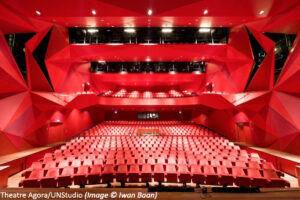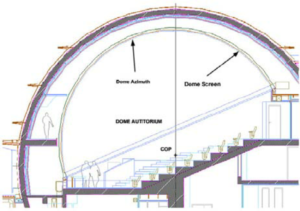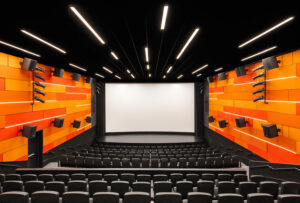Main principles for Movie Theatre design
“What’s a bigger mystery box than a movie theatre? You go to the theatre, you are just so excited to see anything- the moment the lights go down is often the best part.”
-J. J. Abrams

The architectural design of movie theatres plays a vital role in enhancing the cinematic experience for movie goers. Well thought-out layouts and integration of cutting-edge technology are essential in creating an immersive and comfortable environment. In this post, we will explore the principles of architectural design for movie theatres, including the best layouts, the use of technology, and examples of exceptional cinema designs.
Layout considerations
The layout of a cinema theatre is fundamental to the comfort and enjoyment of the audience. Here are some key principles for designing optimal layouts:
Seating arrangement
The seating arrangement should provide an unobstructed view of the screen from every seat. Stadium-style seating, with tiered rows, is a common and effective choice to ensure that even the back rows have an excellent view. Additionally, ensuring ample leg room and comfortable seats is crucial for the audience’s comfort.
Acoustics
Effective sound distribution is essential for a high-quality movie experience. Architects must consider the acoustic properties of the space, incorporating sound-absorbing materials, ensuring proper speaker placement, and minimizing sound leakage to adjacent auditoriums.
Screen placement
The placement of the movie screen should be carefully designed to ensure that it’s visible from all angles within the theatre. A large, curved screen can enhance the immersive experience, allowing the audience to feel surrounded by the action.
Aisles and exits
Adequate spacing for aisles and exits is crucial for safety and accessibility. Well-designed pathways ensure that patrons can easily enter and exit the theatre without disrupting others.

Use of technology
Advancements in technology have revolutionized the cinematic experience. Here are some architectural considerations for incorporating technology into movie theatres:
High-quality projection systems
Cutting-edge projection systems, such as 4K and IMAX, provide exceptional image quality. The design of the theatre should accommodate the necessary equipment and ensure optimal sightlines for the audience.
Immersive audio
State-of-the-art audio systems, like Dolby Atmos, create a 3-dimensional sound experience. Architects must integrate speakers throughout the space to envelop the audience in sound.
Lighting control
Lighting control systems should be designed to allow for a seamless transition from ambient lighting to complete darkness during the movie. This enhances the immersive experience and minimizes distractions.
Accessibility features
Incorporating technology to accommodate patrons with disabilities, such as hearing-impaired, and visually-impaired individuals, is a critical aspect of modern theatre design. This includes closed captioning, audio description services, and wheel-chair accessible seating.

Examples of exceptional cinema designs
Several movie theatres around the world serve as outstanding examples of architectural design that combine innovative layout and technology:
The ArcLight Cinerama Dome, Los Angeles
Features a large curved screen, a dome-shaped roof, and an immersive sound system.
UCI IMAX Colchester, UK
Known for its IMAX screen and exceptional sound, offers an incredibly immersive cinematic experience. Layout incorporates comfortable seating with leg room and excellent lighting arrangement.
Cineteca Nacional, Mexico City, Mexico
This cultural complex includes modern cinema spaces that provide top-notch projection and sound quality. Exemplifies how architectural design can blend with cultural and historical elements to create a unique movie going experience.
Architectural design for movie theatres is a multi-dimensional endeavor that requires careful considerations of layout, technological integration and accessibility. Exceptional cinema designs aim to create an immersive and comfortable environment for the audience. The best layouts incorporate stadium-style seating, optimize acoustics and prioritize screen placement, while technology plays a crucial role in providing high-quality visuals and audio. Following these fundamental principles, architects can create movie theatres that deliver unforgettable cinematic experiences. We shall be back soon with some real examples of extraordinary movie theatre examples from India and abroad. Don’t miss the fun!
Sources
https://www.arch2o.com › theater-design-7-for-designin…
https://unic-cinemas.org › Publications › UNIC…
https://tkarch.com › using-set-design-principles-movie…
https://www.cedengineering.com › userfiles › I…

